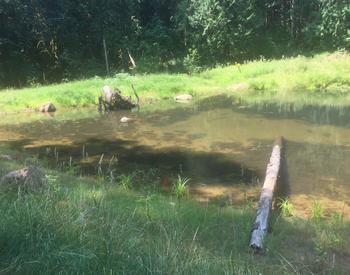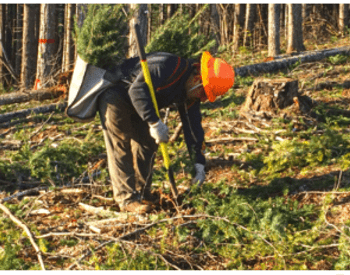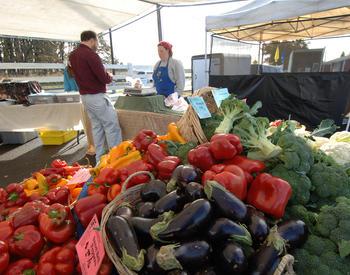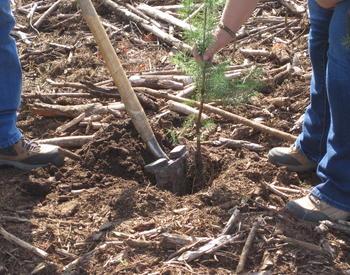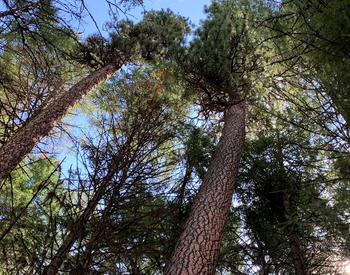Introduction
Timber harvesting can be used to achieve a number of different objectives for your woodland property.
Landowners may choose to cut trees on their property to produce revenue from timber. Others may want to create wildlife habitat, manage for older forest structure, develop a fire-resilient forest, or a combination of those. In any case, there are many things to consider when managing a timber sale.
Make a management plan
First, carefully consider your goals as a woodland owner. Identify what is most important to you when completing work on your land. One approach is to create a forest management plan. You can find lots of information and resources to help you create a plan in the "Know Your Forest" learning library.
Maintaining forest health, habitat creation, income, and recreation are all goals that might drive you to do a timber harvest. When reflecting on your goals and the state of your forest, develop a list of objectives — action items — to achieve these goals. How will the harvest meet your goals for a certain unit, your property, and the larger landscape? For example, there may be forest units on your property better suited for timber production, while others might have wonky trees better for wildlife habitat. Match your goals to the characteristics of your forest.
Outline economic considerations. Timber harvest profitability is driven by the total volume of wood removed, distance to the mill, timber prices, and log quality. Conduct an inventory and talk to log buyers to quantify how much wood you have and how much it is worth.
The right technique
Once you have a plan, identify the management technique to achieve your objectives. This technique should fit the structure of the forest and the ecosystem you are in. Thinnings improve the existing stand, regulate growth, and bring in revenue. Regeneration cuttings remove older trees and create favorable conditions for regenerating young trees. In even-aged forests, regeneration after harvesting (clearcut, seedtree, or shelterwood) creates a whole new forest stand of the same age. In uneven or multiaged forest stands, selective harvesting of individual trees or groups of trees over a period of time creates multiple generations (cohorts) of trees with different age classes within the stand.
Find a mill with product lines that best match your logs. Log buyers have the expertise to determine this match. Contact at least three buyers if possible. After you estimate your logs' value at different mills, factor in the cost of transportation. A higher price at one mill might not be the best option for you if it is farther away.
Prices are typically higher in winter and early spring, when wet-weather restrictions create a shortage of logs. If you have durable or paved roads, or live in an area where winter hauling is possible, take advantage of those higher prices! However, if you need to add rock to your dirt roads in order to haul in wet weather, be prepared to harvest a large volume of good quality timber to offset the cost of road construction. It is always important to re-evaluate prices when the time to harvest gets close.
Forest health
You may also be considering taking additional steps on your property to benefit from fire resilience or forest health. This work may require special equipment such as a stash buster, mulcher, etc. These machines can be expensive, but if you can couple them with a harvest of valuable timber, you may be able to offset the cost instead of paying completely out-of-pocket. Consider these treatments an investment into your property.
Once you have made the decision to harvest, you need to find a logging contractor. If you do not have a working relationship with a contractor, ask other landowners who have worked with one. Most loggers get jobs by word-of-mouth. Ask for references. Also, ensure the contractor has adequate equipment and works with a contract and insurance. (Learn more about choosing and working with a logging contractor.)
Preparing for the harvest
In preparation for the harvest, make sure that the property boundaries are clear and that the trees you plan to harvest are within your property line. If unsure, contact a licensed surveyor who canprovide a legally valid assessment in case of a dispute. If you are planning a regeneration cut, you should also be making plans for reforestation, including placing a seedling order. Replanting is required when you remove most of the trees in one area. Seedlings usually have a 1- to 2-year waiting period, so plan on ordering your seedlings when you schedule your logging contractor.
The Forest Practices Act outlines Oregon’s state laws that protect soil, water, wildlife habitat, and land use. It is your responsibility as a landowner to comply with these rules, regulations and Best Management Practices to avoid fines and make sure you and the contractor are performing a responsible operation.
Your property will look different after the operation. This difference increases with the intensity of the treatment. If you are considering a harvest for the first time, visit a recent job similar to what you are planing so you know what to expect. Your local Small Woodland Owner Association chapter can help you find other active landowners and schedule a visit. This will help you manage your expectations by visualizing possible elements of the harvest that you did not think about before.
Timber harvest is a complex process so give yourself time to prepare and plan. It often takes up to two years for landowners to get from early planning to harvest completion. Your local Extension agent has lots of resources that can help you along the way.
This article originally published in the Fall 2019 issue of Woodland Notes Newsletter

